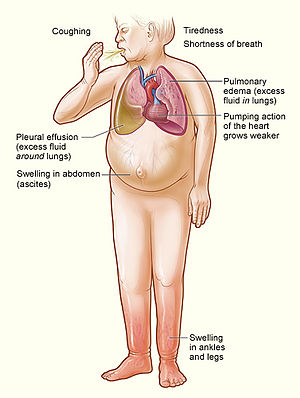ภาวะหัวใจวาย
| ภาวะหัวใจวาย (heart failure) | |
|---|---|
| ชื่ออื่น | congestive heart failure (CHF), congestive cardiac failure (CCF)[1][2] |
 | |
| สัญญาณและอาการหลักของภาวะหัวใจวาย | |
| สาขาวิชา | Cardiology |
| อาการ | Shortness of breath, feeling tired, leg swelling[3][4] |
| ระยะดำเนินโรค | Usually lifelong |
| สาเหตุ | Heart attack, high blood pressure, abnormal heart rhythm, excessive alcohol use, infection, heart damage[4][5] |
| ปัจจัยเสี่ยง | Smoking, sedentary lifestyle, exposure to second-hand smoke[6] |
| วิธีวินิจฉัย | Echocardiogram[7] |
| โรคอื่นที่คล้ายกัน | Kidney failure, thyroid disease, liver disease, anemia, obesity[8] |
| ยา | Diuretics, cardiac medications[7][9] |
| ความชุก | 40 million (2015),[10] 1–2% of adults (developed countries)[5][11] |
| การเสียชีวิต | 35% risk of death in first year[4] |
ภาวะหัวใจวาย หรือ ภาวะหัวใจล้มเหลว (อังกฤษ: heart failure (HF)) มักใช้หมายถึงภาวะหัวใจวายเรื้อรัง (อังกฤษ: chronic heart failure (CHF)) เกิดเมื่อหัวใจไม่สามารถสูบฉีดเลือดเพียงพอเพื่อคงการไหลของเลือดเพื่อสนองความต้องการของร่างกาย[12][13][14] คำว่า โรคหัวใจเลือดคั่ง (อังกฤษ: congestive heart failure (CHF) หรือ congestive cardiac failure (CCF)) มักใช้แทนคำว่า หัวใจวายเรื้อรัง ได้[15] อาการและอาการแสดงโดยทั่วไปมีหายใจกระชั้น เหนี่อยเกิน และขาบวม[4] การหายใจกระชั้นมักเลวลงเมื่อออกกำลังกาย เมื่อนอนราบและเมื่อกลางคืนขณะหลับ[4] มักมีข้อจำกัดปริมาณการออกกำลังกายที่ผู้ป่วยทำได้ แม้รักษาอย่างดีแล้ว[16]
สาเหตุทั่วไปของภาวะหัวใจวาย ได้แก่ โรคหลอดเลือดหัวใจซึ่งรวมกล้ามเนื้อหัวใจตายเหตุขาดเลือด (อาการหัวใจล้ม) ก่อนหน้านี้, ความดันโลหิตสูง, หัวใจห้องบนเต้นแผ่วระรัว (atrial fibrillation), โรคลิ้นหัวใจ (valvular heart disease), และโรคกล้ามเนื้อหัวใจ (cardiomyopathy)[4][5] สาเหตุเหล่านี้ทำให้เกิดอาการหัวใจล้มโดยเปลี่ยนโครงสร้างหรือการทำหน้าที่ของหัวใจ[4] มีอาการหัวใจล้มสองประเภทหลัก คือ อาการหัวใจล้มจากการทำหน้าที่ผิดปรกติของหัวใจห้องล่างซ้ายและอาการหัวใจล้มโดยมีเศษส่วนการสูบฉีดปกติแล้วแต่ว่าหัวใจห้องล่างซ้ายมีความสามารถหดตัวหรือไม่ หรือความสามารถคลายตัวของหัวใจ[4] ปกติจัดลำดับความรุนแรงของโรคจากความสามารถการออกกำลังกายที่ลดลง[8] ภาวะหัวใจวายมิใช่อย่างเดียวกับกล้ามเนื้อหัวใจตายเหตุขาดเลือดหรือหัวใจหยุด (ซึ่งเลือดหยุดไหลทั้งหมด)[17][18] ฦโรคอื่นซึ่งอาจมีอาการคล้ายกับภาวะหัวใจวาย เช่น โรคอ้วน ปัญหาไต ปัญหาตับ โลหิตจาง และโรคไทรอยด์ เป็นต้น[8]
การวินิจฉัยภาวะนี้อาศัยประวัติของอาการและการตรวจร่างกาย ยืนยันด้วยการบันทึกภาพหัวใจด้วยคลื่นเสียงความถี่สูง (echocardiography)[7] การตรวจเลือด การบันทึกคลื่นไฟฟ้าหัวใจและการฉายรังสีทรวงอกอาจมีประโยชน์เพื่อตัดสินสาเหตุเบื้องหลัง[7] การรักษาขึ้นอยู่กับความรุนแรงและสาเหตุของโรค[7]. ในผู้ที่ป่วยเรื้อรังอยู่แล้วในสถานการณ์คงตัว โดยทั่วไปการรักษาประกอบด้วยมาตรการวิถีชีวิตอย่างการหยุดสูบบุหรี่[9] การออกกำลังกาย[19] และการเปลี่ยนแปลงอาหาร ตลอดจนยารักษาโรค[9] ในผู้ทีมีภาวะหัวใจวายเนื่องจากการทำหน้าที่ผิดปรกติของห้องล่างซ้าย แนะนำยายับยั้งเอนไซม์เปลี่ยนแองจิโอเทนซิน (angiotensin converting enzyme inhibitor) และบีตาบล็อกเกอร์ (beta blockers)[7] สำหรับผู้ที่มีโรครุนแรง, อาจใช้สารต้านแอลโดสเตอโรน (aldosterone antagonists), ตัวยับยั้งตัวรับแองจิโอเทนซิน (angiotension receptor blocker) หรือไฮดราลาซีน (hydralazine) ร่วมกับไนเตรต[7] หากมีเศษส่วนการสูบฉีดปกติ ควรรักษาปัญหาสุขภาพที่สัมพันธ์[7] ยาขับปัสสาวะมีประโยชน์ป้องกันการคั่งของของไหลและแนะนำให้ใช้[9] แล้วแต่สาเหตุ บางครั้งเครื่องมือฝังอย่างตัวคุมจังหวะหรือเครื่องรักษาหัวใจเต้นแผ่วระรัวแบบฝังได้ (implantable cardiac defibrillator) อาจเป็นประโยชน์[7] อาจแนะนำเครื่องช่วยหัวใจห้องล่างหรือในบางโอกาส การปลูกถ่ายหัวใจ ในผู้ที่เป็นโรครุนแรงและรักษาด้วยวิธีอื่นไม่ได้ผล[9]
ภาวะหัวใจวายเป็นภาวะที่พบทั่วไป เสียค่าใช้จ่าย และทำให้เสียชีวิตได้[5] ในประเทศที่พัฒนาแล้ว ประมาณ 2% ของผู้ใหญ่มีภาวะหัวใจวาย และในผู้อายุมากกว่า 65 ปี ตัวเลขนี้เพิ่มขึ้นเป็น 6-10%[5][20] หนึ่งปีหลังการวินิจฉัย ความเสี่ยงการเสียชีวิตอยู่ที่ประมาณ 35% แล้วลดลงไปต่ำกว่า 10% ในแต่ละปี[4] เลขนี้คล้ายกับความเสี่ยงของมะเร็งหลายชนิด[4] ในสหราชอาณาจักร โรคนี้เป็นสาเหตุการรับเข้าโรงพยาบาลฉุกเฉิน 5%[4] มนุษย์รู้จักภาวะหัวใจวายมาแต่โบราณกาล โดยพาไพรัสเอแบส์ออกความเห็นเมื่อประมาณ 1550 ปีก่อนคริสตกาล[16].
ดูเพิ่ม
[แก้]อ้างอิง
[แก้]- ↑ Harrison RN, Daly L (2011). A Nurse's Survival Guide to Acute Medical Emergencies (ภาษาอังกฤษ). Elsevier Health Sciences. p. 26. ISBN 978-0-7020-4900-2.
- ↑ "Congestive heart failure (CHF)" (ภาษาอังกฤษ). สืบค้นเมื่อ 12 November 2018.
- ↑ "Living Well With Chronic Heart Failure" (PDF). Heart Foundation. p. 18. คลังข้อมูลเก่าเก็บจากแหล่งเดิม (PDF)เมื่อ 22 ธันวาคม 2014. สืบค้นเมื่อ 25 พฤษภาคม 2014.
- ↑ 4.00 4.01 4.02 4.03 4.04 4.05 4.06 4.07 4.08 4.09 4.10 "Chronic Heart Failure: National Clinical Guideline for Diagnosis and Management in Primary and Secondary Care: Partial Update". National Clinical Guideline Centre: 19–24. Aug 2010. PMID 22741186.
- ↑ 5.0 5.1 5.2 5.3 5.4 McMurray JJ, Pfeffer MA (2005). "Heart failure". Lancet. 365 (9474): 1877–89. doi:10.1016/S0140-6736(05)66621-4. PMID 15924986.
- ↑ Skipina, T. M.; Upadhya, B.; Soliman, E. Z. (July 2021). Munafò, Marcus (บ.ก.). "Secondhand Smoke Exposure is Associated with Prevalent Heart Failure: Longitudinal Examination of the National Health and Nutrition Examination Survey". Nicotine & Tobacco Research. Oxford University Press on behalf of the Society for Research on Nicotine and Tobacco. 23 (9): 1512–1517. doi:10.1093/ntr/ntab047. eISSN 1469-994X. ISSN 1462-2203. LCCN 00244999.
- ↑ 7.0 7.1 7.2 7.3 7.4 7.5 7.6 7.7 7.8 "Chronic Heart Failure: National Clinical Guideline for Diagnosis and Management in Primary and Secondary Care: Partial Update". National Clinical Guideline Centre: 34–47. Aug 2010. PMID 22741186.
- ↑ 8.0 8.1 8.2 "Chronic Heart Failure: National Clinical Guideline for Diagnosis and Management in Primary and Secondary Care: Partial Update". National Clinical Guideline Centre: 38–70. Aug 2010. PMID 22741186.
- ↑ 9.0 9.1 9.2 9.3 9.4 "Chronic Heart Failure: National Clinical Guideline for Diagnosis and Management in Primary and Secondary Care: Partial Update". National Clinical Guideline Centre: 71–153. Aug 2010. PMID 22741186.
- ↑ "Global, regional, and national incidence, prevalence, and years lived with disability for 310 diseases and injuries, 1990-2015: a systematic analysis for the Global Burden of Disease Study 2015". Lancet. 388 (10053): 1545–1602. October 2016. doi:10.1016/S0140-6736(16)31678-6. PMC 5055577. PMID 27733282.
- ↑ Ponikowski P, Voors AA, Anker SD, Bueno H, Cleland JG, Coats AJ, และคณะ (August 2016). "2016 ESC Guidelines for the diagnosis and treatment of acute and chronic heart failure: The Task Force for the diagnosis and treatment of acute and chronic heart failure of the European Society of Cardiology (ESC). Developed with the special contribution of the Heart Failure Association (HFA) of the ESC" (PDF). European Journal of Heart Failure (Review). 18 (8): 891–975. doi:10.1002/ejhf.592. hdl:2434/427148. PMID 27207191. S2CID 221675744.
- ↑ heart failure ใน พจนานุกรมศัพท์การแพทย์ดอร์แลนด์
- ↑ "Heart failure". Health Information. Mayo Clinic. 23 December 2009. DS00061.
- ↑ "Definition of Heart failure". Medical Dictionary. MedicineNet. 27 April 2011. คลังข้อมูลเก่าเก็บจากแหล่งเดิมเมื่อ 2011-12-08. สืบค้นเมื่อ 2014-09-07.
- ↑ "Living Well With Chronic Heart Failure" (PDF). Heart Foundation. p. 18. คลังข้อมูลเก่าเก็บจากแหล่งเดิม (PDF)เมื่อ 2014-12-22. สืบค้นเมื่อ 25 May 2014.
- ↑ 16.0 16.1 McDonagh, Theresa A. (2011). Oxford textbook of heart failure. Oxford: Oxford University Press. p. 3. ISBN 9780199577729.
- ↑ Willard & Spackman's occupational therapy (12th ed.). Philadelphia: Wolters Kluwer Health/Lippincott Williams & Wilkins. 2014. p. 1124. ISBN 9781451110807.
- ↑ Eyal Herzog (2012). The Cardiac Care Unit Survival Guide. Lippincott Williams & Wilkins. p. 98. ISBN 9781451177466.
- ↑ Taylor, RS; Sagar, VA; Davies, EJ; Briscoe, S; Coats, AJ; Dalal, H; Lough, F; Rees, K; Singh, S (Apr 27, 2014). "Exercise-based rehabilitation for heart failure". The Cochrane database of systematic reviews. 4: CD003331. doi:10.1002/14651858.CD003331.pub4. PMID 24771460.
- ↑ Dickstein K, Cohen-Solal A, Filippatos G; และคณะ (October 2008). "ESC Guidelines for the diagnosis and treatment of acute and chronic heart failure 2008: the Task Force for the Diagnosis and Treatment of Acute and Chronic Heart Failure 2008 of the European Society of Cardiology. Developed in collaboration with the Heart Failure Association of the ESC (HFA) and endorsed by the European Society of Intensive Care Medicine (ESICM)". Eur. Heart J. 29 (19): 2388–442. doi:10.1093/eurheartj/ehn309. PMID 18799522.
{{cite journal}}: CS1 maint: multiple names: authors list (ลิงก์)
แหล่งข้อมูลอื่น
[แก้]- Heart failure, American Heart Association – information and resources for treating and living with heart failure
- Heart Failure Matters – patient information website of the Heart Failure Association of the European Society of Cardiology
- Heart failure in children by Great Ormond Street Hospital, London, UK
- "Heart Failure". MedlinePlus. U.S. National Library of Medicine.
| การจำแนกโรค | |
|---|---|
| ทรัพยากรภายนอก |
